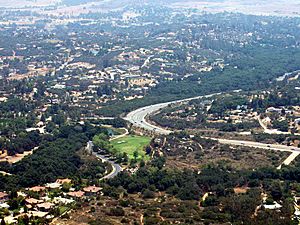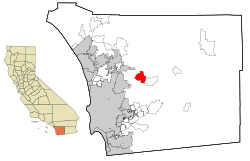Ramona, San Diego County, California facts for kids
Quick facts for kids
Ramona
|
|
|---|---|

Mt. Woodson community in Ramona
|
|

Location in San Diego County and the state of California
|
|
| Country | United States |
| State | California |
| County | San Diego |
| Area | |
| • Total | 38.433 sq mi (99.539 km2) |
| • Land | 38.412 sq mi (99.485 km2) |
| • Water | 0.021 sq mi (0.054 km2) 0.05% |
| Elevation | 1,430 ft (436 m) |
| Population
(2020)
|
|
| • Total | 21,468 |
| • Density | 558.582/sq mi (215.674/km2) |
| Time zone | UTC−8 (Pacific) |
| • Summer (DST) | UTC−7 (PDT) |
| ZIP code |
92065
|
| Area codes | 442/760 |
| FIPS code | 06-59346 |
| GNIS feature ID | 1652781 |
Ramona is a special kind of community in San Diego County, California. It's called a census-designated place (CDP). This means it's an area that looks like a town but isn't officially a city. In 2020, about 21,468 people lived there.
The name Ramona can also mean a larger area. This includes the Ramona CDP and another nearby community called San Diego Country Estates. Together, these areas had about 30,301 people in 2010.
Contents
Discovering Ramona's Past
Early People and Land Grants
Long ago, the Ramona area was home to the Kumeyaay Nation. These Native Americans were semi-nomadic. They moved between the coast and inland areas, setting up camps in Ramona each year. We know they were there from old rock paintings, etchings, and grinding stones. They used these stones to make flour from acorns for bread.
Later, when California was under Mexican rule, a large piece of land called Rancho Valle de Pamo was created. This ranch covered about 17,709 acres (71.66 km²) in the Santa Maria Valley, where Ramona is today.
How Ramona Got Its Name
The first post office in the area was named Nuevo. In 1886, a group of people bought 3,200 acres (13 km²) to build a town. They named it Ramona. This name came from a popular novel called Ramona by Helen Hunt Jackson. The book made people interested in Southern California.
For a short time, the town went back to being called Nuevo. This was because there was another town named Ramona in Los Angeles County. But that other town didn't grow. So, in 1894, Nuevo officially became Ramona again. Today, there's a Mexican restaurant in Ramona called "Nuevo Grill" that remembers the town's first name.
Important Buildings and History
In 1886, Theophile Verlaque built the first house in Ramona. This house is now the Ramona Pioneer Historical Society and its Guy B. Woodward Museum. It's even listed on the National Register of Historic Places.
The Ramona Town Hall is another historic building. It was built in 1894 with money donated by Augustus and Martha Barnett. A famous architect named William S. Hebbard designed it. The Town Hall is one of the oldest and largest adobe buildings in Southern California.
Ramona in the Spotlight
In the 1960s, famous boxer Archie Moore had a training camp in Ramona. He called it "Salt Mine." Great boxers like George Foreman and Muhammad Ali trained there. Moore's camp had five homes, a boxing ring, and miles of trails for running.
Ramona also made national news in 1973. A famous tennis match between Bobby Riggs and Margaret Court happened at San Diego Country Estates in Ramona. Riggs won that match.
Major Fires and Recovery
Ramona has faced large wildfires. The Cedar Fire started near Ramona in 2003. It burned about 280,000 acres (1,100 km²) and destroyed many homes. It was the biggest fire in California at that time.
In 2007, the Witch Fire also began near Ramona. This fire burned about 195,000 acres (790 km²) and destroyed over 640 homes. Roads into Ramona were closed. These fires caused huge evacuations, with over 500,000 people having to leave their homes.
Ramona's Location and Landscape
Ramona is located in the Santa Maria Valley. It's near where State Route 67 and State Route 78 meet. The town is about 1,391 feet (424 meters) above sea level.
Since Ramona isn't an official city, its size is measured in different ways. The Ramona Community Planning Area (RCPA) is the main way its land area is measured. This area covers over 84,000 acres (340 km²) in central San Diego County.
The RCPA includes the Santa Maria Valley and the San Vicente Valley. It's located in the foothills of the Laguna Mountains. Ramona is east of Poway, southeast of Escondido, north of Lakeside, California, and west of Santa Ysabel, California.
Ramona's Weather
Ramona has a Mediterranean climate. This means it has warm, dry summers and mild, wet winters. The temperature can change a lot between day and night. Since 1974, the lowest temperature recorded was 16°F (-9°C) in January 2007. The highest was 117°F (47°C) in July 2018.
| Climate data for Ramona Airport (1991–2020 normals, extremes 1974–present) | |||||||||||||
|---|---|---|---|---|---|---|---|---|---|---|---|---|---|
| Month | Jan | Feb | Mar | Apr | May | Jun | Jul | Aug | Sep | Oct | Nov | Dec | Year |
| Record high °F (°C) | 90 (32) |
89 (32) |
94 (34) |
98 (37) |
107 (42) |
109 (43) |
117 (47) |
111 (44) |
112 (44) |
105 (41) |
95 (35) |
94 (34) |
117 (47) |
| Mean maximum °F (°C) | 80.5 (26.9) |
80.6 (27.0) |
83.2 (28.4) |
89.0 (31.7) |
90.9 (32.7) |
96.2 (35.7) |
100.3 (37.9) |
102.0 (38.9) |
102.2 (39.0) |
96.1 (35.6) |
87.7 (30.9) |
80.2 (26.8) |
105.6 (40.9) |
| Mean daily maximum °F (°C) | 66.2 (19.0) |
65.9 (18.8) |
67.7 (19.8) |
71.7 (22.1) |
75.5 (24.2) |
82.9 (28.3) |
88.9 (31.6) |
90.8 (32.7) |
87.4 (30.8) |
80.0 (26.7) |
72.5 (22.5) |
65.6 (18.7) |
76.3 (24.6) |
| Daily mean °F (°C) | 51.4 (10.8) |
51.9 (11.1) |
53.8 (12.1) |
57.3 (14.1) |
62.2 (16.8) |
67.5 (19.7) |
73.2 (22.9) |
74.7 (23.7) |
71.2 (21.8) |
64.2 (17.9) |
56.4 (13.6) |
50.6 (10.3) |
61.2 (16.2) |
| Mean daily minimum °F (°C) | 36.5 (2.5) |
37.9 (3.3) |
39.8 (4.3) |
42.8 (6.0) |
48.9 (9.4) |
52.0 (11.1) |
57.5 (14.2) |
58.7 (14.8) |
54.9 (12.7) |
48.5 (9.2) |
40.3 (4.6) |
35.6 (2.0) |
46.1 (7.8) |
| Mean minimum °F (°C) | 25.9 (−3.4) |
28.3 (−2.1) |
30.7 (−0.7) |
33.4 (0.8) |
39.0 (3.9) |
43.2 (6.2) |
47.6 (8.7) |
47.8 (8.8) |
43.8 (6.6) |
36.6 (2.6) |
29.9 (−1.2) |
25.1 (−3.8) |
23.0 (−5.0) |
| Record low °F (°C) | 16 (−9) |
19 (−7) |
24 (−4) |
27 (−3) |
29 (−2) |
36 (2) |
41 (5) |
38 (3) |
39 (4) |
30 (−1) |
22 (−6) |
20 (−7) |
16 (−9) |
| Average precipitation inches (mm) | 3.10 (79) |
3.66 (93) |
2.30 (58) |
1.00 (25) |
0.41 (10) |
0.06 (1.5) |
0.10 (2.5) |
0.04 (1.0) |
0.15 (3.8) |
0.69 (18) |
1.06 (27) |
2.08 (53) |
14.65 (372) |
| Average precipitation days (≥ 0.01 in) | 6.6 | 8.2 | 7.2 | 6.0 | 4.1 | 1.6 | 0.8 | 1.1 | 1.6 | 3.8 | 4.8 | 7.1 | 52.9 |
| Source: NOAA | |||||||||||||
Who Lives in Ramona?
Population in 2010
In 2010, the Ramona CDP had 20,292 people. Most residents were White (78.3%). About 14.6% were from other races, and 3.6% were from two or more races. Hispanic or Latino people made up 31.2% of the population.
Most people (99.4%) lived in homes. About 25.9% of the population was under 18 years old. The average age was 36.7 years. There were slightly more males than females.
There were 6,627 households. Many (39.7%) had children under 18. Most households (58.7%) were married couples. The average household had about 3 people.
Population in 2000
In 2000, the Ramona Community Planning Area (RCPA) had 33,404 people. About 78.35% were White. Hispanic or Latino people made up 17.03% of the population.
About 30% of the population was under 18. The average age was 35.7 years. Most households (68.5%) were married couples.
The median household income in the RCPA was $60,534. This means half of the households earned more and half earned less. Most homes (72.2%) were owned by the people living in them.
Farming and Agriculture in Ramona
From Turkeys to Eggs
Ramona was once known as the "Turkey Capital of the World." Turkey farming was very popular in the 1930s. They even had annual "Turkey Days" celebrations! But after World War II, turkey farming stopped by 1959.
Then, chicken egg farming grew quickly. It started in the 1920s and was big until the 1970s. In 1970, there were about 50 egg farms. Today, most of these farms are gone. This happened because of more people moving in and land becoming more expensive. Diseases like Newcastle's Disease also affected the chicken farms.
Dairies (farms that produce milk) used to be common too. Now, only one dairy remains.
Growing Grapes and Horses
Today, a big part of Ramona's agriculture is growing wine grapes. The Ramona Valley is a special area for growing grapes. It has unique weather, elevation, and soil.
Ramona is also known for breeding Thoroughbred horses. Golden Eagle Farm in Ramona was home to Best Pal. This horse finished second in the 1991 Kentucky Derby. Best Pal earned over $5.6 million in races, more than any other California-bred racehorse. He is buried at Golden Eagle Farm.
Ramona's Culture and Films
Ramona has been a filming location for several movies. These include South of 8 (2016), The Samuel Project (2018), Why the Nativity? (2022), and Hemet, or the Landlady Don't Drink Tea (2023).
Famous People from Ramona
Many notable people have lived in or had connections to Ramona:
- Budd Boetticher - a film director and producer.
- Johnny Borneman, III - an American racecar driver.
- William Thomas Burns (Sleepy Bill Burns) - a Major League Baseball player.
- William Cagney - a film producer and brother of actor James Cagney.
- Dave Cripe - a baseball player.
- Jake Gagne – a motorcycle racer.
- John Hopkins - another motorcycle racer.
- Ross Martin - an actor known for The Wild Wild West.
- Archie Moore - a world champion boxer who owned a training camp in Ramona. A street there is named after him.
- Larry Poole - an actor and film producer.
- Casey Tibbs - a famous rodeo cowboy and actor.
- Dai Vernon - a well-known magician.
- Nick Vincent - a Major League Baseball pitcher who went to Ramona High School.
- Stanley B. Wilson - a labor leader and newspaper publisher.
Images for kids
See also
 In Spanish: Ramona (condado de San Diego) para niños
In Spanish: Ramona (condado de San Diego) para niños




